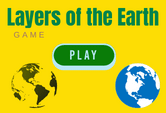Layers of The Earth Crust Game Quiz
This a Layers of The Earth Crust Game Quiz online for students in 5th, 6th, 7th, 8th grades. If you could dig deep into the innermost layer of the earth, you would notice that each layer is unique in its characteristics. Although digging in is not feasible, the earth's crust has been studied and classified into the core, mantle, lithosthere, asthenosphere and crust. The deeper parts of the earth are hot and have a very high pressure. Materials in some areas are in liquid form. Liquid rocks and the convectional forces operating within them lead to movements around the earth that lead to folds, volcanoes, faults and earthquakes. This game is an interactive geography game that contains 15 questions each related to the current topic. It is a great exercise for the classroom or homeschooling. Tell us what you think and please share !

The layers of the earth can be divided into several categories. These categories include the outer core, the mantle, the upper mantle, and the crust. The Earth's layers can be compared and contrasted in terms of their chemical and mechanical properties. In addition to these layers, the Earth is composed of many different types of material, including molten rock, sulfide rock, and iron ore.
Mantle
The upper mantle is made up of a solid rock called the asthenosphere. This layer is weak and ductile, allowing it to flow under the heat of convection forces. These movements cause tectonic plates to move apart. The mantle contains large amounts of solid peridotite. This material is cooled by convection, which causes the Earth's tectonic plates to move.
The Earth's mantle is the outer shell of the planet and is composed of denser rocks than the crust. This part of the Earth lies between 660 and 2,900 km below the surface. The lower mantle is sometimes called the mesosphere, because it is situated between the outer core and the transition zone. There, the temperature is over four thousand degrees Celsius, but the pressure is so high that liquid rock cannot form.
The Earth's mantle contains about 200 million cubic kilometers of water. Temperatures in the mantle range from 200 to four thousand degrees Celsius. Hotter mantle rocks rise, while cooler ones sink. The mantle rocks consist primarily of silicate minerals. Flows of heat through the mantle cause earthquakes and volcanic eruptions.
Lithosphere
The lithosphere is a rigid outer layer of the Earth; it is where we live. The Earth's mantle is 100% magma and is about four thousand miles below the surface. The lithosphere is on top of the mantle and is 50-100 kilometers thick. Its temperature is 300-500 degrees Celsius, while the asthenosphere is about four hundred degrees Celsius.
The lithosphere provides the materials we need for our daily lives. It is the source of fuels such as petroleum, coal, and gas. The lithosphere contains waters that are necessary for the survival of all living organisms on Earth. Humans are destroying the lithosphere in many ways. Scientists estimate that one ton of trash per person is thrown away each year. This is a major problem. We must ensure that the lithosphere is protected so that our planet remains healthy and safe.
Asthenosphere
The asthenosphere is a layer that lies above the outer core of the Earth and below the lithosphere. This layer is characterized by low flow resistance, making it more fluid than the lithosphere. The asthenosphere is the primary source of heat from the Earth's interior and is responsible for a variety of natural phenomena. Below the asthenosphere, temperatures range from below the melting point to above the freezing point.
During periods of rapid plate drift apart, the asthenosphere can partially melt and segregate at increasing depths. Such processes can be detected with seismic tomography. However, as the Earth ages, the asthenosphere will gradually cool and become less viscous.
Crust
The earth's crust is the uppermost layer of solid material. It is separated from the underlying mantle by its density and susceptibility to surface geological processes. It is composed of minerals, rocks, and liquid water and is subject to the movement of the Earth's plates. The crust is believed to have formed about 4.6 billion years ago. Although it is largely composed of oceanic material, the rocks in the mid-ocean areas are younger than those in the outer parts of the Earth.
The rock constituents of the Earth's crust are mostly oxides, with the exception of fluorine, chlorine, and iron. According to Clarke, nearly half of the Earth's crust is oxygen. Oxygen occurs mainly in the form of oxides, of which silicon is the major component. Other oxides include calcium, magnesium, and sodium. Many igneous and metamorphic rocks are composed of silicate minerals in the crust.
